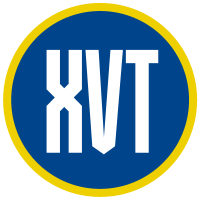XVT
 | |
| Developer(s) | Providence Software Solutions, Inc. |
|---|---|
| Stable release | 12.2
/ February 27, 2012 |
| Operating system | Cross-platform |
| Type | Development Library |
| License | Proprietary |
| Website | www.xvt.com |
- XvT is also an abbreviation for the X-Wing vs. TIE Fighter video game
- xvt is also an X Window System terminal emulator created by John Bovey of the University of Kent at Canterbury.
XVT is a software development environment for building cross-platform GUI applications in C or C++. XVT allows developers to graphically lay out an application's GUI, and provides cross-platform libraries to aid development.
XVT has been in development since 1989 and has provided a cross-platform software development toolkit for the majority of that time. XVT software is utilized in a number of mission-critical production sites and applications.
Their approach is not as a widget replacement look-alike set, but acts more like a universal API translator. XVT is an "abstraction layer" that removes the developer from being concerned with which OS the application will run on. When your application is compiled, the XVT API points to the native controls/widgets for the OS on which you are compiling your code. This matters to OS user-purists, who can be very fussy when the views "aren't quite right." It also allows you to build applications that will adapt whatever user themes the OS allows users to set.
There are other uses of this product beyond cross platform development (though it does this well). As a CASE tool, a non-programmer business analyst can actually lay out all the user interfaces, review them with end users and subject matter experts in a RAD-like (Rapid Application Development) requirements capture by functional review, and then the XVT architect tool will deliver the C or C++ (ANSI-compliant) code. This would take a bit of familiarity with a compiler and the layout tools, but it would allow programmers to be relieved of coding GUI and focus their work on the business logic, event handling, etc.
The developers have announced support for GTK+ on Linux and Cocoa on Mac, but these ports are not yet available. Because Microsoft no longer support the HLP help format, XVT applications require the user to install the Microsoft .hlp viewer.
XVT was originally developed by Advanced Programming Institute in Boulder Co., a company founded by Marc Rochkind. The company changed its name to XVT when that product became the main company effort. The XVT product was purchased by Providence Software Solutions, Inc. in 2001.
Platforms
XVT currently supports:
With XVT, applications can be designed and developed once and then subsequently compiled on any of these platforms.
Editions
XVT DSC
XVT DSC includes the PTK, or Portability ToolKit, and the XVT Design interface designer. It is designed for use with C.
XVT DSP
XVT DSP includes the PTK, Power++ library (C++ bindings to the PTK), and the XVT Architect interface designer. It is designed for use with C++.
XVT Net
XVT Net allows applications built using either of the other editions to be recompiled as a networked application. The application may then be run on a server which thin clients can connect to in order to use the application.
